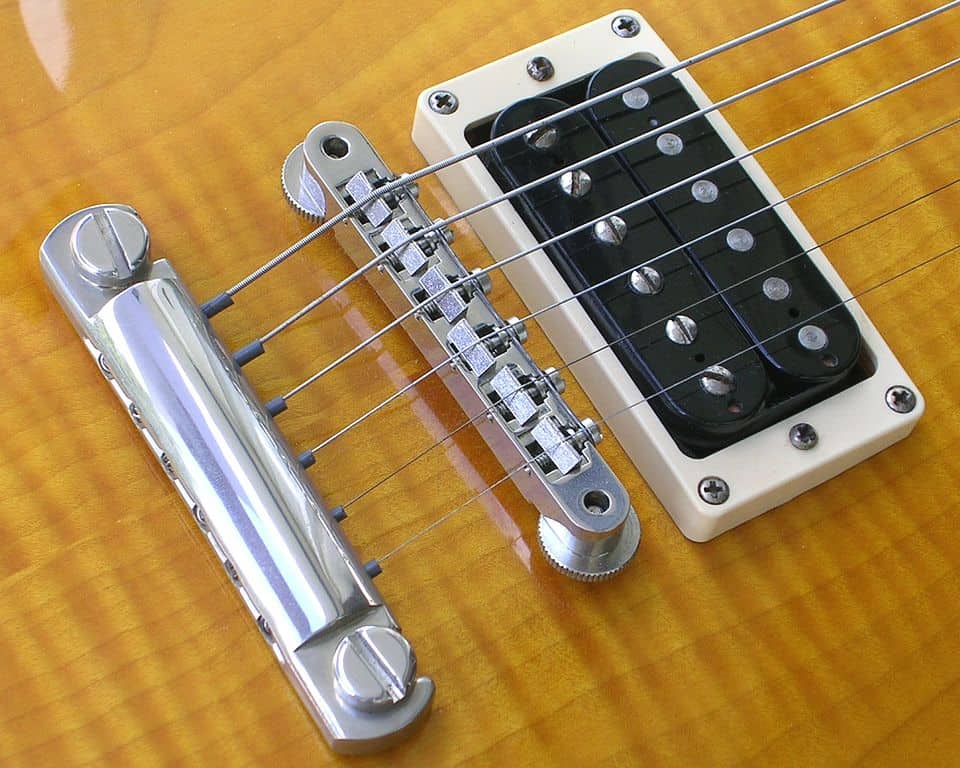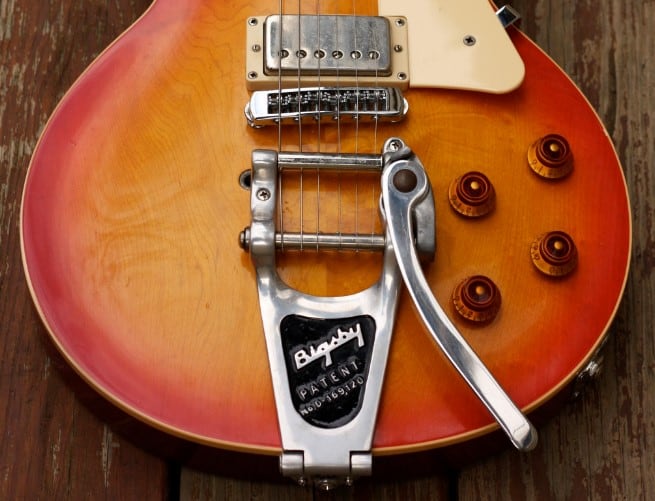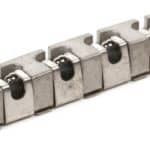An age-old question that itches many players is whether to stick with a traditional Tune O Matic bridge or go for a roller bridge.
But did you know roller bridges are actually a type of Tune O Matic?
The main difference between them is that the roller implements a mechanism that lets the strings move more easily.
But I will discuss that later.
If you want a quick answer about the main differences and implications of both these 2 kinds of guitar bridges, here it is:
Tune O Matic (TOM) bridges are fixed and usually paired with stop tails. Roller bridges are a type of TOM bridge that incorporates spinning saddles that roll when the string moves. This is why they are usually paired with vibrato tailpieces such as Bigsby or Maestro ones as they help with tuning stability.
For those who want to stick with me for a bit longer, in this article, I will dive deeper into the differences between these slightly different guitar bridges.
I will also talk about the main reasons to pick one over the other.
Without further to do, then:
Are you ready to get started?
Let’s go!
The case for a Tune O Matic bridge

The Tune O Matic bridge was designed by Ted McCarty and introduced in the year 1953.
It has been there forever, as you can see.
It’s a fixed bridge, that’s usually accompanied by a stop tailpiece. But it’s also commonly used with other kinds of tailpieces and string-through body constructions.
This bridge design is the go-to for many brands and builders, and an undoubted classic in the industry.
Its ubiquity is probably thanks to a very simple factor: It just works.
Why go for a Roller bridge
However, the simplicity of a Tune O Matic bridge might come short when facing certain hurdles such as tremolo tailpieces.
And I’m sorry for calling your beloved Bigsby a “hurdle”, but for many players, that’s what it is.
When the Bigsby and Maestro vibrola were first introduced, the ever-present original Tune O Matic bridge began showing an undesired behavior:
The excessive friction generated by the movement of the strings when using a tremolo tailpiece started generating tuning stability problems.
Fixed saddles and moving strings are like water and oil.
The solution for this issue was cleverly engineered: Just make each saddle a spinning roller that moves along with the string.
Of course, this added complexity comes at a price, but the benefits to many players are a must-have, and some of them are the following:
- Way less friction when using a tremolo arm
- Consequently, better tuning stability
- Longer string life
- Lower string break angle
- Better intonation when set up correctly
- Softer on the hand
On the other side, the higher price I mentioned is not only a figurative form of speech, but also a metaphor referring to harder setups, and the claim of reduced sustain by some players.
But do you really need a roller bridge?
Now, the thing to consider here is that if it ain’t broke, don’t fix it.
This is a nice motto to repeat when thinking about upgrading your guitar.
Do you use a tremolo system?
Are you experiencing tuning issues due to string movement?
If not, you are probably better off with a simpler, cheaper Tune O Matic bridge.
Why overcomplicate things?
Roller bridges are great, no doubt about that, but setting them up it’s a bit trickier, they are slightly more massive (adding weight to your instrument), and in most cases, more expensive.
So why bother about an upgrade if you don’t really need it?
On the other hand, if you are really facing any of the aforementioned issues, by all means, stop reading and run to the store to get a roller bridge.
Or, well… You could get one online, probably.
Can any guitar with a Tune O Matic bridge fit a roller bridge?
Since not many guitars come factory equipped with a roller bridge, manufacturers take this into consideration and design them in a way to make them fit in almost any guitar drilled for a Tune O Matic.
Is this an absolute answer? Of course not, your mileage may vary.
There are many options available in the market, and I think you should do some light googling before pulling the trigger.
However, if manufacturers have any business sense at all, it should be as I told you here, and any roller bridge should fit where any Tune O Matic was installed earlier.
My recommendations
As I said above, if you don’t have a real reason to upgrade your bridge, just keep your guitar as is.
If you are shopping for a newer guitar and you face the possibility of getting either of these 2 alternatives, perhaps go for the roller.
Especially if the instrument has a vibrato tailpiece.
In any other case, it wouldn’t be a life-changing experience. You would probably not notice any difference at all in tone or playability.
But hey, I know modding a guitar is not a rational way of life, so go do what your heart tells you is best, and just have fun.

Hello there, my name is Ramiro and I’ve been playing guitar for almost 20 years. I’m obsessed with everything gear-related and I thought it might be worth sharing it. From guitars, pedals, amps, and synths to studio gear and production tips, I hope you find what I post here useful, and I’ll try my best to keep it entertaining also.





